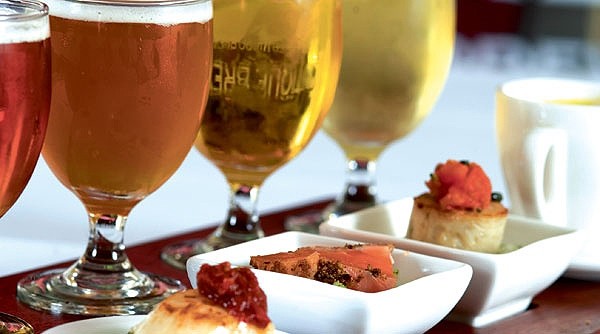
A few years ago, while attending the Great American Beer Festival in Denver, I found myself in a hotel restaurant at breakfast, surrounded by beer geeks of every make and model. Some were drinking beer. “Beer for breakfast?” I thought. And then I remembered some advice that a brewmaster at a local microbrewery once gave me: “Stout is the ultimate breakfast beer,” she said. Now, I don’t normally drink beer for breakfast. But, when in Rome ... or Denver ...
Drinking beer with breakfast may seem a bit whack. But, for some, it’s still a traditional morning beverage in parts of Bavaria, for example. And if you’ve ever spent time in a European train station during the early-morning hours, you know that it’s not unusual at all to see travelers sipping beer, wine, marc and other boozy libations.
Anyway, the point isn’t to convince you to start cracking open cold PBRs with your morning wake-up call. The point is to launch a conversation about beer and food pairings. And one really great one is steel-cut oatmeal with a well-made stout. It’s not surprising that oatmeal stout should have a flavor affinity with a bowl of breakfast oatmeal, since there are actual oats added to the mash when making oatmeal stout. In addition, stout typically has coffee and mocha flavors, which would make it popular with morning java drinkers. Some great choices include Samuel Smith’s Oatmeal Stout and Shakespeare Oatmeal Stout from Rogue Ales. Or, closer to home: Squatters Captain Bastard’s Oatmeal Stout.
As mentioned, stout and oatmeal have an affinity for one another. As with pairing wine and food, there are two main strategies for pairing beer with food. First, as with stout and oatmeal, there are beers and foods that work well together because they have flavor profiles in common. They match strength with strength. Think of a marriage that you know where the couple was just made for each other; they have a lot in common and seem to be able to anticipate one another’s thoughts. Beers and foods that blend well together from a flavor standpoint are like that couple. A good example is roasted pork, which plays beautifully off the deep caramel-like flavors of an Oktoberfest lager. It’s a perfect marriage.
On the other hand (and again, as is the case with wine), there are beers and foods that are good partners because they contrast. This is like the couple—I think most would agree that my wife and I fit the bill here—that would seem to have nearly nothing in common, yet somehow they just work together. Opposites attract. The best wine pairing example I can think of to illustrate this pairing principle is what sommelier/wine expert Josh Wesson calls “Blockbuster helper,” the pairing of two opposites: popcorn and sparkling wine. Try it some movie night. The acidic, crisp, slightly sweet bubbly cuts right through the fatty butter and mouth-puckering salt in popcorn like a laser. It’s a perfect contrasting pairing.
Likewise, there’s a reason that India Pale Ale goes so well with Indian cuisine that goes beyond just the name. A tangy, high-hopped IPA is a really good foil for incendiary, highly spiced Indian food like curries and vindaloo, but it also provides an interesting contrast to sweet desserts such as carrot cake.
As with wine, there are no absolute rules about matching beer with food. It’s really a matter of what you like. There are no wrongs or rights. However, there are a few general principles that might lead to more successful pairings. First, when pairing beer with food, think of the “weight” of both. In other words, it’s usually a good idea to pair heavier beers—porter, stout, brown ale, etc.—with heavier foods. You probably wouldn’t want to sip a porter with a salad, but it goes great with barbecued meats, hearty roasted or smoked foods, and cow’s milk cheese like Tilsit. A big, dark imperial stout will overpower many if not most foods, but is one beer that can hold its own next to fatty foie gras and roast goose, duck or pheasant. Ditto doppelbock.
Similarly, lighter beers tend to go best with lighter foods. It’s for good reason that a classic Czech or German pilsner is such a good partner for Wiener schnitzel, but it’s also great with simple chicken dishes and salads. So are cream ale, blonde ale and Kölsch, the latter of which really rocks the Monterey Jack quesadilla. Probably not too surprisingly, a British-style bitter beer or “session” beer is a slam-dunk with fish & chips and also pairs very nicely with mild English cheeses like Leicester and Sage Derby.
There are some specific beer/food interactions to consider when trying to find a perfect match. For example, maltiness and sweetness in beer helps balance out spiciness and acidity in food. That’s why a Vienna Lager or Märzen works well with spicy Mexican and Asian dishes. Bitterness from hops tends to complement heat from chilies, which again is why hoppy IPAs pair nicely with fiery Indian food. In general, you can usually substitute a lighter, hoppy beer with any food that would normally call for a crisp white wine. On the other hand, alcohol tends to balance out fatty richness in food, which is why you want to look toward higher-alcohol brews like barley wine, imperial stout, abbey dubbel and such with hearty roasts, meat pies, game and the like—foods that would normally cry out for a big, robust red wine.
Want to try out your beer and food-pairing prowess? With more than 125 brews to choose from and dozens of different foods, the Utah Beer Festival 2013 on Aug. 17 is the perfect place to do it.
Twitter: @Critic1